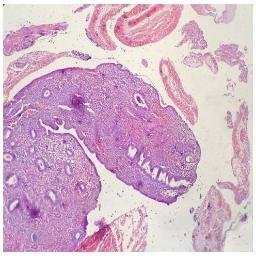Virus Expression Database



Submitted by Gerburg M Wulf (Beth Israel Deaconess Medical Center, USA) on May 03 2016
Platform: microarray – [HT_HG-U133_Plus_PM] Affymetrix HT HG-U133+ PM Array Plate 
Pubmed: 27333046
Summary Whether the human tumor virus, Epstein-Barr virus (EBV) promotes breast cancers remains controversial and a potential mechanism has remained elusive. Here we show EBV can infect primary mammary epithelial cells (MECs) that express the attachment receptor, CD21. EBV infection leads to the expansion of early MEC progenitor cells with a stem cell phenotype and enforces a differentiation block. When MECs were implanted as xenografts, EBV infection cooperated with activated Ras and accelerated the formation of breast cancer. Infection in EBV-related tumors was of a latency type II pattern, including expression of latent membrane proteins 1 (LMP1) and 2 (LMP2), similar to nasopharyngeal carcinoma (NPC). A human gene expression signature for EBVness was generated based on the RNA expression profile of the EBV infected primary mammary epithelial cells, tumors. This was signature associated with high grade (40 vs 13.5%) estrogen-receptor-negative status (31.8 vs. 10.5%, p53 mutation (37.5 vs 14.5%) and poor survival. In 11/33 (33%) of tumors positive for EBVness EBV-DNA was found in tumor cells by fluorescent in situ hybridization for the viral LMP1 and BXLF2 genes, while only 4/36 (11%) of EBVness-negative tumors tested positive for EBV DNA. An analysis of the TCGA breast cancer data revealed a correlation of EBVness with presence of the APOBEC mutational signatures consistent with past viral infection. We conclude that a contribution of EBV to breast cancer etiology via a ‘hit-and-run’ mechanism is plausible, in which EBV infection predisposes mammary epithelial cells to malignant transformation, but is not required for the maintenance of the malignant phenotype.
| ID | Title | Cell Type | Timepoint | Reported Virus | Virus Species | Exclusion Reason |
|---|---|---|---|---|---|---|
| GSM2142062 | EBV-MCF-10A | mammary epithelial cell line  [MCF-10A [MCF-10A  ] ] |
unknown | EBV | Human gammaherpesvirus 4 | |
| GSM2142063 | GFP-MCF-10A | mammary epithelial cell line  [MCF-10A [MCF-10A  ] ] |
unknown | GFP | Uninfected | |
| GSM2142064 | EBV-MCF-10A-R | mammary epithelial cell line  [MCF-10A [MCF-10A  ] ] |
unknown | EBV | Human gammaherpesvirus 4 | Extra interventions Ras12 over-expression |
| GSM2142065 | GFP-MCF-10A-R | mammary epithelial cell line  [MCF-10A [MCF-10A  ] ] |
unknown | GFP | Uninfected | Extra interventions Ras12 over-expression |
| GSM2142066 | EBV-HMEC | mammary epithelial cell line  |
unknown | EBV | Human gammaherpesvirus 4 | |
| GSM2142067 | GFP-HMEC | mammary epithelial cell line  |
unknown | GFP | Uninfected | |
| GSM2142068 | EBV-HMEC-R | mammary epithelial cell line  |
unknown | EBV | Human gammaherpesvirus 4 | Extra interventions Ras12 over-expression |
| GSM2142069 | GFP-HMEC-R | mammary epithelial cell line  |
unknown | GFP | Uninfected | Extra interventions Ras12 over-expression |
| GSM2142070 | GFP-tumor 1 | breast cancer cell  |
unknown | GFP | Uninfected | Extra interventions Generated from Ras12 cell line |
| GSM2142071 | GFP-tumor 2 | breast cancer cell  |
unknown | GFP | Uninfected | Extra interventions Generated from Ras12 cell line |
| GSM2142072 | GFP-tumor 3 | breast cancer cell  |
unknown | GFP | Uninfected | Extra interventions Generated from Ras12 cell line |
| GSM2142073 | GFP-tumor 4 | breast cancer cell  |
unknown | GFP | Uninfected | Extra interventions Generated from Ras12 cell line |
| GSM2142074 | EBV-tumor 1 | breast cancer cell  |
unknown | EBV | Human gammaherpesvirus 4 | Extra interventions Generated from Ras12 cell line |
| GSM2142075 | EBV-tumor 2 | breast cancer cell  |
unknown | EBV | Human gammaherpesvirus 4 | Extra interventions Generated from Ras12 cell line |
| GSM2142076 | EBV-tumor 3 | breast cancer cell  |
unknown | EBV | Human gammaherpesvirus 4 | Extra interventions Generated from Ras12 cell line |
| GSM2142077 | EBV-tumor 4 | breast cancer cell  |
unknown | EBV | Human gammaherpesvirus 4 | Extra interventions Generated from Ras12 cell line |